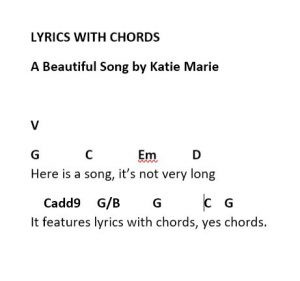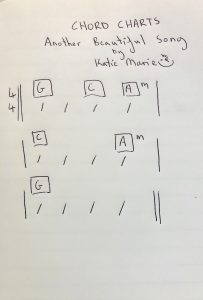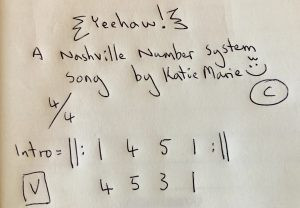Creating accurate and easy-to-read chord charts is an essential skill for any guitarist, especially when collaborating in studio sessions or live performances. Imagine walking into a recording session and being handed a confusing or incomplete chart – it can quickly derail the creative process and waste valuable time. Well-structured chord charts, sometimes referred to as lead sheets, ensure everyone is on the same page, allowing musicians to focus on what truly matters: making great music.
Whether you’re a songwriter preparing for a recording session, a band leader organizing rehearsals, or a guitarist simply wanting to document your song ideas, understanding how to create effective chord charts is crucial. This guide will walk you through different types of chord charts tailored for guitarists, providing you with the knowledge to create charts that are both informative and easy to use.
Understanding Chord Chart Basics
Before diving into specific types of charts, let’s cover some fundamental elements that are common to most chord charts. These basics will form the foundation for clear and concise musical communication.
Song Structure: Your Musical Roadmap
Think of song structure as the blueprint of your music. It outlines the different sections of a song and their order, providing a roadmap for musicians. Common abbreviations are used to represent these sections in a chord chart, making it easy to follow the song’s progression:
- Verse (V): The storytelling section of the song, often with changing lyrics but a recurring chord progression.
- Chorus (CH or C): The main, often repeated section of the song, typically the most memorable part.
- Bridge (B or BD): A contrasting section that provides a change of pace or perspective, often appearing later in the song. In the UK, this is also commonly referred to as a “Middle 8” (M8).
- Intro (Intro): The beginning section of the song, setting the musical stage.
- Outro (Outro): The ending section of the song, providing closure.
- Instrumental (Inst): Sections where there are no vocals and instruments take the lead.
By clearly labeling these sections in your chord chart, you provide a clear overview of the song’s form, allowing guitarists to anticipate what’s coming next.
Time Signatures: The Rhythm’s Framework
The time signature indicates how many beats are in each measure (or bar) and what kind of note gets one beat. For guitar chord charts, the time signature is usually placed at the beginning of the chart. The most common time signature in popular music is 4/4, which means there are four beats per measure, and a quarter note receives one beat. Understanding the time signature is essential for rhythmically placing chords within the music.
Rhythm Notation: Indicating Chord Duration
While chord charts primarily focus on chord changes, they often include rhythm markings to give guitarists a sense of how long to play each chord within a measure. One common method is using lines or dashes below the chords to represent beats. For example, in 4/4 time:
G C Am D
| | | |
This indicates each chord gets one beat. If you want to hold a chord for longer, you can extend the lines:
G C Am D
| | | |
Here, ‘G’ gets two beats, and ‘C’, ‘Am’, and ‘D’ each get one beat. Another approach is to simply space the chords visually to represent their duration within the bar.
Types of Chord Charts for Guitar
Now, let’s explore different types of chord charts, each with its advantages and best use cases for guitarists.
1. Lyrics with Chords
 Lyrics with chords
Lyrics with chords
Lyrics with chords are arguably the most straightforward type of chord chart, particularly popular among beginner guitarists and singers. As the name suggests, chords are written directly above the lyrics where the chord change occurs.
Example:
(G)I woke up this (C)morning,
(G)Sunlight in my (D)eyes.Pros for Guitarists:
- Easy to Read: Very intuitive and requires minimal music reading knowledge.
- Focus on Song Flow: Keeps the lyrics central, helping guitarists follow the song’s narrative.
- Great for Jamming & Practice: Ideal for informal settings, rehearsals, and personal practice.
Cons for Guitarists:
- Rhythmic Ambiguity: Doesn’t precisely indicate chord duration or placement within the bar.
- Less Detail: Lacks information about song structure, instrumental breaks, or specific rhythmic figures.
- Not Ideal for Complex Music: Can become cluttered and hard to follow in songs with rapid chord changes or intricate rhythms.
Best Used For: Simple songs, folk tunes, pop songs with straightforward chord progressions, initial songwriting sessions.
2. Standard Chord Charts
 Chord Charts
Chord Charts
Standard chord charts, often simply called “chord charts,” provide a more structured way to represent a song’s chords and rhythm. They typically display chords arranged in measures, reflecting the song’s time signature. Rhythm markings are often included to clarify the duration of each chord.
Example (in 4/4 time):
| G G | C Am | D G | C G |Pros for Guitarists:
- Rhythmic Clarity: Rhythm markings or visual spacing provides a clearer sense of chord duration.
- Structured Format: Measures and bar lines make it easier to follow the song’s form.
- More Detail than Lyrics/Chords: Can include song section labels (Verse, Chorus, etc.) above the chord progression.
Cons for Guitarists:
- Still Lacks Fine Detail: Doesn’t show specific guitar voicings, strumming patterns, or melodic information.
- Requires Some Music Reading: Understanding of measures and basic rhythm notation is helpful.
Best Used For: Most genres of music, band rehearsals, studio sessions where a balance of simplicity and clarity is needed, songs with moderate rhythmic complexity.
3. Nashville Number System for Guitar
 Nashville Number System
Nashville Number System
The Nashville Number System is a brilliant and efficient method, particularly favored in country, bluegrass, and pop music circles. Instead of writing out chord names (like G, C, D), it uses numbers to represent chords within a key. This system offers incredible flexibility, especially when working with guitarists.
How it Works for Guitarists:
In any major key:
- 1 = Major Chord (Tonic)
- 2 = Minor Chord (Supertonic)
- 3 = Minor Chord (Mediant)
- 4 = Major Chord (Subdominant)
- 5 = Major Chord (Dominant)
- 6 = Minor Chord (Submediant)
- 7 = Diminished Chord (Leading Tone)
For example, in the key of G major:
- 1 = G Major
- 2 = Am Minor
- 3 = Bm Minor
- 4 = C Major
- 5 = D Major
- 6 = Em Minor
- 7 = F# Diminished
Example (Verse in G Major):
| 1 1 | 4 5 | 1 1 | 2 2 |This translates to:
| G G | C D | G G | Am Am |Pros for Guitarists:
- Key Transposition on the Fly: The biggest advantage! You can change the key instantly without rewriting the chart. For example, if the singer wants to raise the key a whole step to A major, the numbers remain the same, and you simply apply them to the A major scale. This is incredibly useful in rehearsal and performance scenarios, especially for guitarists who are often asked to change keys.
- Simplified Charts: Numbers are quicker to write and read than full chord names.
- Focus on Harmonic Function: Encourages understanding of chord relationships within a key, improving your musical ear and improvisation skills on guitar.
Cons for Guitarists:
- Initial Learning Curve: Requires understanding of basic key theory and the number system itself.
- Less Direct for Beginners: Might be less intuitive for guitarists who are completely new to chord charts.
Best Used For: Working with singers or other instrumentalists who may need to change keys frequently, songs where arrangement is still evolving, genres where improvisation and flexibility are valued, more experienced guitarists.
4. Full Guitar Score (Standard Notation)
While less common for typical chord charts focused on studio sessions, it’s worth mentioning full scores using standard music notation. These are highly detailed and notate every aspect of the music, including melody, harmony, rhythm, and often specific guitar parts (if written for guitar).
Pros for Guitarists (for advanced players):
- Maximum Detail: Provides the most precise information about every note, rhythm, and articulation.
- Complete Musical Picture: Shows the entire arrangement, allowing guitarists to see their part in context.
- Ideal for Complex Arrangements: Necessary for intricate compositions, classical guitar pieces, or highly arranged studio work.
Cons for Guitarists (for most situations):
- Steep Learning Curve: Requires advanced music reading skills, which many contemporary guitarists may not possess.
- Time-Consuming to Create: Creating full scores is significantly more laborious than chord charts.
- Overkill for Simple Chord-Based Music: Unnecessary for most pop, rock, blues, or folk songs where chord charts suffice.
Best Used For: Classical guitar music, complex instrumental pieces, film scoring, situations where precise notation of every musical detail is required, highly skilled guitarists who are fluent in music notation.
Tips for Creating Effective Guitar Chord Charts
No matter which type of chord chart you choose, these best practices will ensure your charts are clear, accurate, and helpful for guitarists:
- Clarity is Key: Write legibly! Use clear fonts or handwriting, and ensure chords and section labels are easy to distinguish.
- Accuracy is Paramount: Double-check your chords and song structure against the recording or your song idea. Mistakes on the chart lead to mistakes in performance.
- Consistency Matters: Use the same formatting and abbreviations throughout the chart.
- Include Essential Information: Always include the song title, composer, key (unless using Nashville Numbers), and time signature.
- Use Chord Diagrams (Optional but Helpful): For guitarists unfamiliar with certain chord voicings, adding chord diagrams can be a great visual aid, especially for less common chords.
- Section Breaks: Clearly separate song sections (Verse, Chorus, etc.) with blank lines or visual breaks to improve readability.
- Listen and Verify: After creating your chart, play along with the song using your chart to ensure accuracy and usability.
Conclusion
Creating effective chord charts is a valuable skill for any guitarist involved in songwriting, recording, or performing with other musicians. By understanding the different types of chord charts and applying the principles of clarity and accuracy, you can create charts that streamline rehearsals, enhance studio sessions, and ensure everyone is playing from the same musical page. Experiment with the different methods, find what works best for you and your musical collaborators, and start charting your way to smoother and more productive music making!
